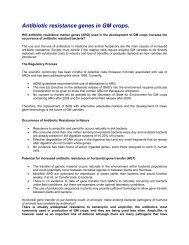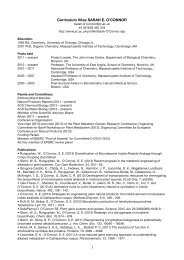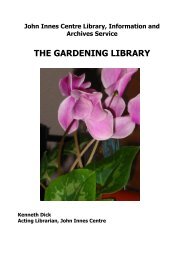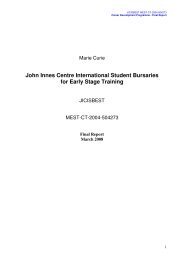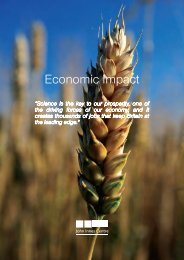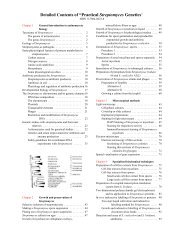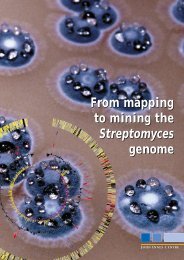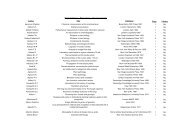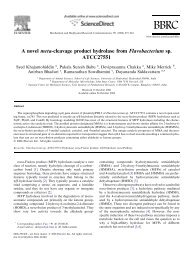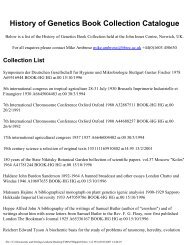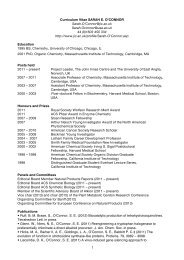1910s Timeline - John Innes Centre
1910s Timeline - John Innes Centre
1910s Timeline - John Innes Centre
Create successful ePaper yourself
Turn your PDF publications into a flip-book with our unique Google optimized e-Paper software.
inhibits the spindle fibres so that<br />
sets of divided chromosomes<br />
fail to separate and are enclosed<br />
in a common nuclear<br />
membrane). The multiplication<br />
of chromosomes is also often<br />
associated with desirable traits<br />
in the plants such as being larger<br />
in size and more robust. Hence<br />
the ‘Colchicine Method’ is seen<br />
as potentially useful for making<br />
artificial polyploids (plants with<br />
cells that contain multiple,<br />
complete sets of<br />
chromosomes). In many cases<br />
colchicine is found to be much<br />
more effective in inducing<br />
polyploidy than the ‘heat-shock’<br />
treatments that are already in<br />
use.<br />
By the early 1940s many<br />
experiments are underway at<br />
JIHI to produce new polyploids.<br />
These studies have gathered<br />
sufficient momentum by 1943<br />
for C D Darlington to announce<br />
‘the invention of new methods<br />
of making polyploid plants’ (by<br />
P. T. Thomas in the Pomology<br />
Department) as a major branch<br />
of plant breeding work at JIHI.<br />
The intention is that the new<br />
polyploids will be used either to<br />
produce new hybrids, or to<br />
preserve existing hybrids by<br />
restoring their fertility. For the<br />
first time the prospect of<br />
creating new ‘synthetic’ plants is<br />
opened up and the term<br />
‘genetics engineer’ is already in<br />
circulation. Much later, the<br />
possession of this new<br />
molecular tool was important in<br />
getting biologists to think of<br />
biological processes in<br />
molecular terms (Goodman<br />
1998).<br />
See also:<br />
Jordan Goodman, ‘Plants, Cells<br />
and Bodies: The Molecular<br />
Biography of Colchicine, 1930-<br />
1975’, pp. 17-46 in Soraya de<br />
Chadarevian and Harmke<br />
Kamminga (eds), Molecularizing<br />
Biology and Medicine,<br />
Amsterdam: Harwood<br />
Academic Publishers, 1998.<br />
M. Crane and D. Lewis,<br />
‘Genetical studies in pears’,<br />
Journal of Genetics, 43 (1942):<br />
31-43.<br />
[Gordon Haskell], ‘Making new<br />
plants: the Colchicine Method’,<br />
in The Fruit, the Seed and the<br />
Soil, Edinburgh: Oliver and<br />
Boyd, 1949 and later editions.<br />
O. J. Eigsti and P. Dustin Jr.,<br />
Colchicine in Agriculture,<br />
Medicine, Biology and Chemistry,<br />
Ames, Iowa: Iowa State College<br />
Press, 1955.<br />
1943 Discovery of<br />
Streptomycin<br />
The success of penicillin<br />
stimulated Selman Waksman, a<br />
soil microbiologist at Rutgers<br />
University in New Jersey, in<br />
1940 to examine the collection<br />
of actinomycete bacteria that<br />
he had assembled over thirty<br />
years for antibiotic production.<br />
Soon after, in1943, Waksman’s<br />
group discovers streptomycin, a<br />
natural product made by the<br />
bacteria Streptomyces griseus.<br />
By 1947 streptomycin –<br />
commercialised by the<br />
American pharmaceutical<br />
company Merck and Co., who<br />
had supported Waksman’s<br />
research- proves to be<br />
wonderfully successful against<br />
tuberculosis, a major killer<br />
disease worldwide for which<br />
there has been no effective drug<br />
treatment. Streptomycin is also<br />
effective against several other<br />
diseases and its discovery is<br />
followed by the finding of many<br />
further antibacterial and<br />
antifungal drugs. The<br />
actinomycetes shoot to fame<br />
from relative obscurity and<br />
many actinomycete products<br />
are discovered in the 1950s and<br />
1960s in a period afterwards<br />
regarded as the ‘Golden Age’ of<br />
antibiotic discovery.<br />
Page 38 of 91



